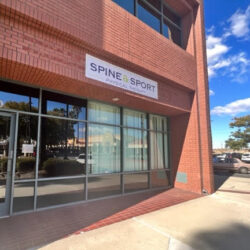The basics of a rotator cuff tear
- A rotator cuff tear is a rip in either the muscle or tendon of one of the four rotator cuff muscles (supraspinatus, infraspinatus, teres minor and subscapularis).
- A tear often occurs due to injury or wear and tear, either from aging or as a result of repeatedly performing the same shoulder motions.
- Rotator cuff injuries have many names: rotator cuff strain, shoulder impingement, rotator cuff impingement, rotator cuff tendonitis, rotator cuff partial tear and rotator cuff full thickness tear.
- Symptoms of a torn rotator cuff include loss of function, shoulder pain and weakness.
- Treatment options include physical therapy, rest, exercise, medication, corticosteroid injections and surgery.
- Physical therapy treatments for rotator cuff injuries include inflammation and pain reduction modalities, stretching and joint mobilization, and strengthening for the rotator cuff, scapular stabilizers and postural muscles.
Move forward, faster, fearlessly
What is the rotator cuff?
The shoulder is one of the most mobile joints in the body. This mobility allows us to throw a football, paint a ceiling or even scratch between our shoulder blades. To achieve this heightened range of motion, the joint has a loose joint capsule and ligaments. Stability for the shoulder is provided by a group of four muscles called the rotator cuff.
These four rotator cuff muscles (supraspinatus, infraspinatus, teres minor and subscapularis) have a primary job of creating internal or external rotation motions in the shoulder. They also have a secondary job of keeping the head of the humerus in the socket during outer range motions, especially when lifted overhead.
When any of the rotator cuff muscles are injured, we lose range of motion, stability and strength in the shoulder, and therefore we lose the ability to function. In addition to this loss of function, typically an injury to any of the rotator cuff muscles is incredibly painful.
Rotator cuff injuries
The rotator cuff is a commonly injured area. The most common rotator cuff injuries are strains, tears and tendinitis.
A torn rotator cuff refers to tissue damage or disruption to the muscles or tendons. These often result from trauma, daily use of the shoulder or degradation. Tears are classified as full-thickness tears or partial-thickness tears and can range in severity or size.
Repetitive, overhead motions can also wear down the rotator cuff muscles. As a result, people over the age of 40 are at higher risk of having a rotator cuff tear. Those who participate in jobs or sports with repetitive motions or lifting are also at an increased risk of injury.
Each year, about 2 million people in the United States see a doctor for a rotator cuff problem, according to the American Academy of Orthopedic Surgeons (AAOS).
In addition to care from a doctor, physical therapy is an excellent treatment for many rotator cuff tears. This involves improving the patient’s strength, coordination and range of motion. Physical therapy can be pursued by the patient without a doctor’s referral – this is called Direct Access.
If the patient sees a doctor, physical therapy is likely prescribed either as the first line of treatment or for rehabilitation following surgery. If treated, most rotator cuff injuries can heal. If the injury is severe or left untreated, this can lead to prolonged issues and even require surgery.
Torn rotator cuff symptoms
- Pain with raising the arm or reaching. This is known as a painful arc of motion.
- Limited range of motion with overhead motions or across body motions.
- When lying on affected side, pain in that side’s shoulder.
- Pain in the lateral aspect of the shoulder.
- Pain in shoulder positions where the elbow is elevated (upright row position).
- Weakness of the shoulder especially away from the body.
- Difficulty lifting objects.
Causes for rotator cuff tears
Injury, such as a fall, and deterioration from repetitive use are the two main causes of rotator cuff tears.
When the shoulder is repetitively used during sports, exercise, work or other activities, the tendons and muscles get over-stressed, leading to a strain, tear or other injury. These are known as chronic rotator cuff tears.
Injury can also occur as a result of a traumatic injury, such as a car accident or fall. These tears, which are known as acute tears, often cause immediate and intense pain.
Risk factors for developing a shoulder rotator cuff tear
- Poor posture.
- Participating in recreational or professional sports.
- Age 40 and above.
- Trauma.
- Overuse.
- Poor general health including history of obesity, smoking, diabetes, etc.
Diagnosing a partial or complete torn rotator cuff
A physical therapist or a doctor can diagnose rotator cuff tears during a physical examination(s) and full medical history including documenting symptoms and history. They will also assess a patient’s ability to move the arm through evaluative tests that may indicate a rotator cuff tear or rule out similar injuries. Some of the tests include the following:
- Hawkins-Kennedy test. Shoulder flexed to 90 degrees, elbow flexed to 90 degrees. Passive shoulder internal rotation will cause pain.
- Apley scratch test. One hand is reached over the back and the other is reached over the shoulder. The physical therapist evaluates the pain or limitation on the injured shoulder.
- Hornblower’s sign test. The arm is raised to the side and the elbow is bent at 90 degrees. The arm is then externally rotated. There is difficulty in rotating the arm with the torn rotator cuff.
- Drop arm test. The arm is raised at the side as high as possible and then lowered to 90 degrees. There is difficulty in holding the arm with the torn rotator cuff at 90 degrees.
- Yocum’s test.The hand is placed on the opposite shoulder while the physical therapist tries to push it down from 90 degrees. Pain will implicate the rotator cuff.
- Jobe’s “empty can” test. The arm is lifted against the resistance of the therapist with the thumbs facing down. Pain or weakness can indicate injury.
- Imaging tests. X-rays, MRI or other imaging tests may be utilized to confirm a diagnosis or where the tear is located.
These clinical examination tests and the diagnostic imaging will determine if the patient requires surgery or can manage the injury through physical therapy.
Risks of not treating a cuff tear
Early intervention is important as an untreated partial rotator cuff tear can increase over time without it. Long-term damage can result. The patient will likely continue to have pain and lose function. Day to day activities such as grooming, dressing and driving a car can become difficult.
Seeking treatment early, whether that is with a doctor or a physical therapist, helps speed the rehabilitation and prevents further damage.
Physical therapy treatments for rotator cuff tear
Specific treatment recommendations depend on a person’s age, overall health, activity level and the severity of injury or pain. General treatment options include:
- The patient rests the shoulder, avoids activity that aggravates the tear, and does light loading exercising to reduce pain and improve range of motion.
- Arm immobilizers may be used to limit activity and movement.
- Medications to reduce the swelling and pain.
- Steroid injections to reduce the swelling and pain.
- Physical therapy exercises to reduce pain, strengthen muscles and increase range of motion.
- Surgery if the tear does not respond to nonsurgical treatment or is too severe for conservative treatments.
Research shows no evidence that timing surgery affects outcomes, according to AAOS, meaning nonsurgical methods are often recommended first before surgery options.
The goal of physical therapy is to help the individual regain movement and strength in the injured shoulder. Exercises include:
- Scapular stabilization exercises.
- Isometric, concentric and eccentric loading exercises.
- Active assistive exercises to regain range of motion early in the treatment plan (using a pulley system, cane or golf club to help lift the arm).
- More advanced rotator cuff strengthening may be applied using a pulley system, resistance band, weight or a dumb bell when the injury is appropriately healed.
During therapy, the therapist will evaluate the stage of healing for the injury and adjust the plan accordingly. This evaluation and re-evaluation takes pain, range of motion, strength and functional capacity into account. Progression through a physical therapy plan should require several weeks to several months.
A comprehensive home exercise program helps to provide some loading and strengthening while away from the clinic. Rotator cuff tears may not respond to physical therapy. In these cases, our therapists may recommend speaking to an orthopedist about more aggressive options including biologic injections (PRP, stem cells) and surgeries.
Learn more about physical therapy exercises
Physical therapy after surgery
A surgically repaired cuff is vulnerable to re-injury. Proper physical therapy post-surgery treatment is crucial in preparing the shoulder for return to full activity.
Physical therapy after surgery proceeds in four phases. Phase I begins when the patient’s repaired arm is in a sling and aims to reduce pain and slowly restore movement. After this initial protective phase, loading, resistance and coordination exercises are added into the program as appropriate to the stage of healing. Our physical therapists guide patients through, from gentle range-of-motion activities to full use in nonstressful daily activities and finally sports-specific rehabilitation exercises.
The time rehabilitation takes depends on several factors. Generally, patients can expect rehab to last from 4-6 months before beginning to return to normal activities and sports. It may take a year before full return to all activities.
When to see a doctor for cuff tears
A person should see a doctor if experiencing immediate weakness after injury. This may be a sign of a significant tear. A medical professional can diagnosis the tear and severity. Acute tears may require surgery, often followed by physical therapy.
Get informed
- Orthopedic Chronic Pain &
Other Chronic Health Conditions - Pain Management With Physical
Therapy - Physical Therapy Services
- Shoulder
Pain
Spine & Sport clinics offering rotator tear physical therapy near me
All of our clinics in Southern & Northern California offer physical therapy services for a rotator cuff tear.
 South San Diego County
South San Diego County Central San Diego County
Central San Diego County East San Diego County
East San Diego County North San Diego County
North San Diego County Orange County
Orange County Imperial County
Imperial County Coachella Valley
Coachella Valley Riverside County
Riverside County Ventura County
Ventura County Los Angeles County
Los Angeles County Northern California
Northern California